(HR7002) - Organisational Behaviour and Global Strategy
VerifiedAdded on 2023/07/04
|10
|3865
|445
AI Summary
This document is a final assessment for a course on Organisational Behaviour and Global Strategy. It analyzes the organizational strategy of Domino's Pizza, an American pizza chain founded in 1960. The company has over 17,000 stores in more than 90 countries and is known for its commitment to innovation and delivering high-quality pizzas quickly. The document discusses the company's unique business strategy, its use of data analytics, and its centralised organisational structure with a franchise model. It also examines a historical event that required exceptional crisis management and change delivery, using John Kay's Competitive Advantage Framework. The document concludes with recommendations for the company.
Contribute Materials
Your contribution can guide someone’s learning journey. Share your
documents today.
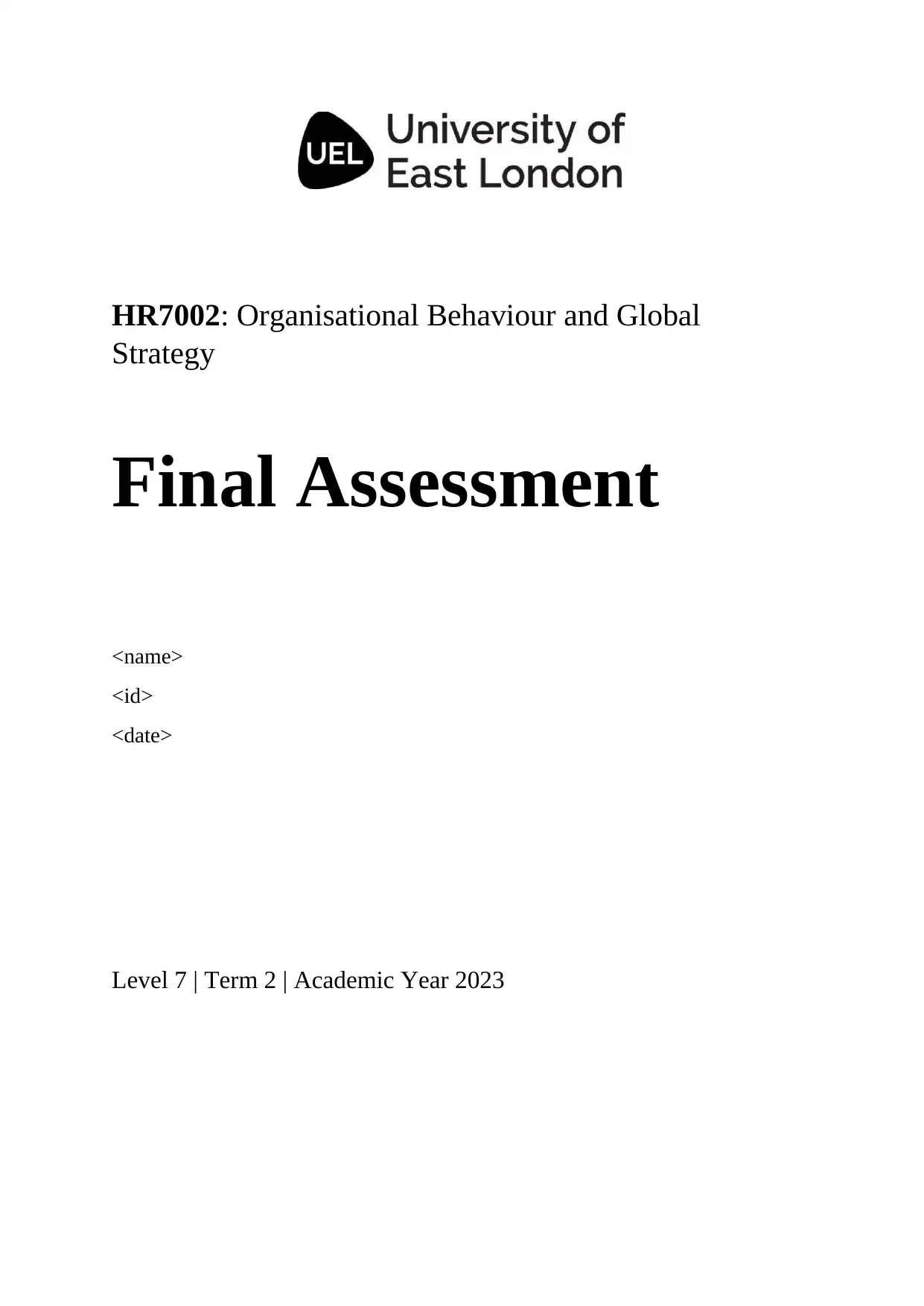
HR7002: Organisational Behaviour and Global
Strategy
Final Assessment
<name>
<id>
<date>
Level 7 | Term 2 | Academic Year 2023
Strategy
Final Assessment
<name>
<id>
<date>
Level 7 | Term 2 | Academic Year 2023
Secure Best Marks with AI Grader
Need help grading? Try our AI Grader for instant feedback on your assignments.
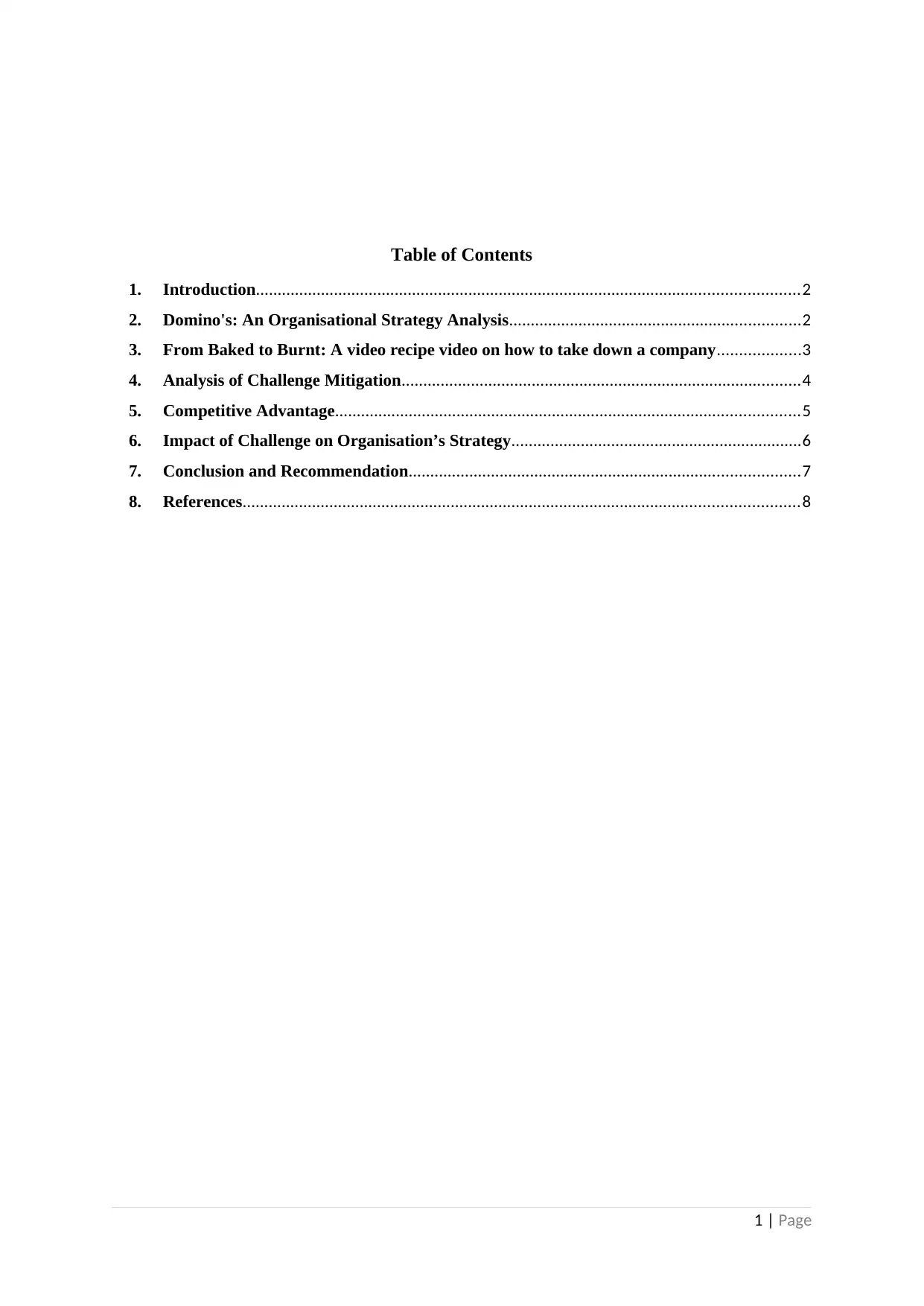
Table of Contents
1. Introduction.............................................................................................................................2
2. Domino's: An Organisational Strategy Analysis...................................................................2
3. From Baked to Burnt: A video recipe video on how to take down a company...................3
4. Analysis of Challenge Mitigation............................................................................................4
5. Competitive Advantage...........................................................................................................5
6. Impact of Challenge on Organisation’s Strategy...................................................................6
7. Conclusion and Recommendation..........................................................................................7
8. References................................................................................................................................8
1 | Page
1. Introduction.............................................................................................................................2
2. Domino's: An Organisational Strategy Analysis...................................................................2
3. From Baked to Burnt: A video recipe video on how to take down a company...................3
4. Analysis of Challenge Mitigation............................................................................................4
5. Competitive Advantage...........................................................................................................5
6. Impact of Challenge on Organisation’s Strategy...................................................................6
7. Conclusion and Recommendation..........................................................................................7
8. References................................................................................................................................8
1 | Page
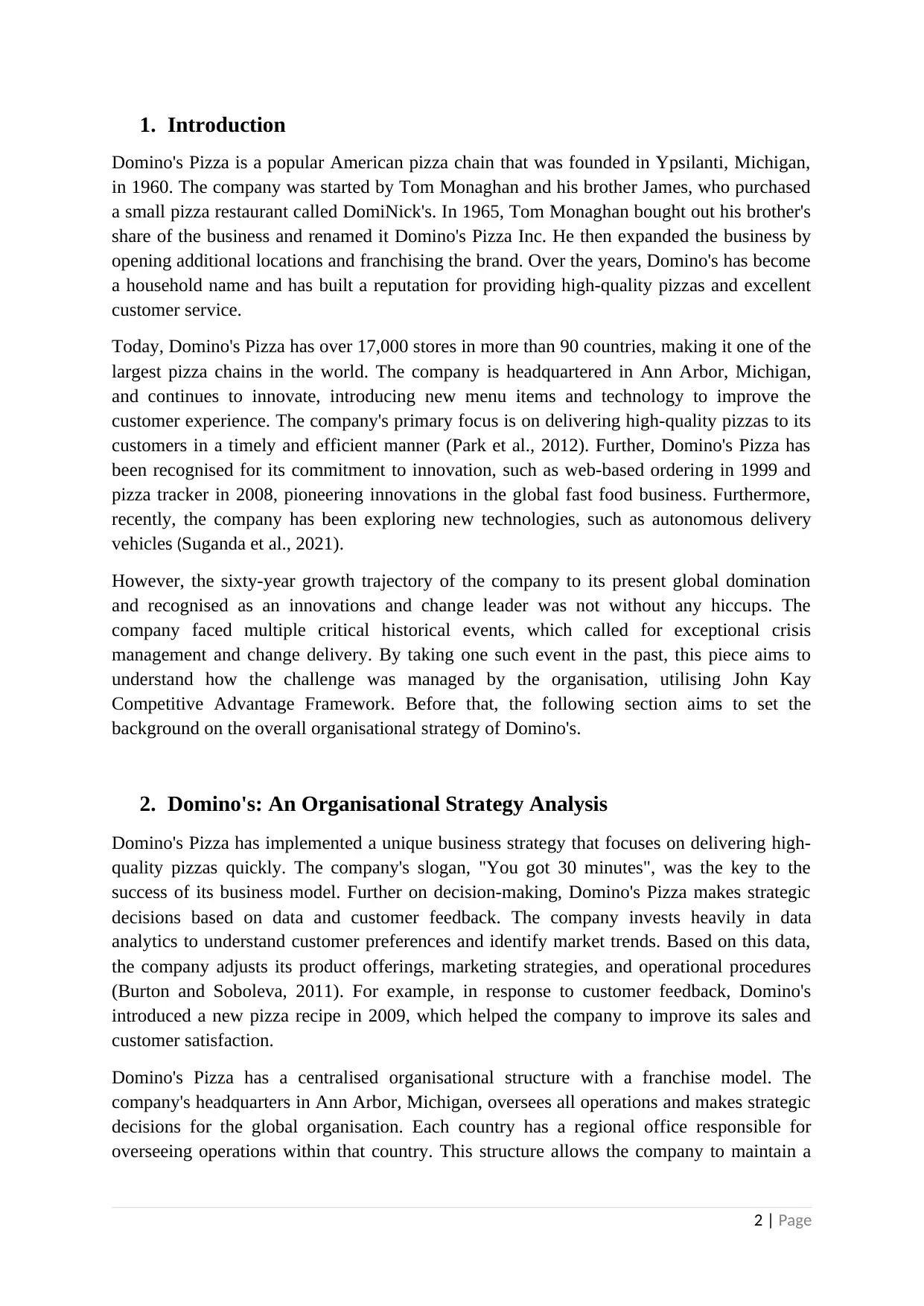
1. Introduction
Domino's Pizza is a popular American pizza chain that was founded in Ypsilanti, Michigan,
in 1960. The company was started by Tom Monaghan and his brother James, who purchased
a small pizza restaurant called DomiNick's. In 1965, Tom Monaghan bought out his brother's
share of the business and renamed it Domino's Pizza Inc. He then expanded the business by
opening additional locations and franchising the brand. Over the years, Domino's has become
a household name and has built a reputation for providing high-quality pizzas and excellent
customer service.
Today, Domino's Pizza has over 17,000 stores in more than 90 countries, making it one of the
largest pizza chains in the world. The company is headquartered in Ann Arbor, Michigan,
and continues to innovate, introducing new menu items and technology to improve the
customer experience. The company's primary focus is on delivering high-quality pizzas to its
customers in a timely and efficient manner (Park et al., 2012). Further, Domino's Pizza has
been recognised for its commitment to innovation, such as web-based ordering in 1999 and
pizza tracker in 2008, pioneering innovations in the global fast food business. Furthermore,
recently, the company has been exploring new technologies, such as autonomous delivery
vehicles (Suganda et al., 2021).
However, the sixty-year growth trajectory of the company to its present global domination
and recognised as an innovations and change leader was not without any hiccups. The
company faced multiple critical historical events, which called for exceptional crisis
management and change delivery. By taking one such event in the past, this piece aims to
understand how the challenge was managed by the organisation, utilising John Kay
Competitive Advantage Framework. Before that, the following section aims to set the
background on the overall organisational strategy of Domino's.
2. Domino's: An Organisational Strategy Analysis
Domino's Pizza has implemented a unique business strategy that focuses on delivering high-
quality pizzas quickly. The company's slogan, "You got 30 minutes", was the key to the
success of its business model. Further on decision-making, Domino's Pizza makes strategic
decisions based on data and customer feedback. The company invests heavily in data
analytics to understand customer preferences and identify market trends. Based on this data,
the company adjusts its product offerings, marketing strategies, and operational procedures
(Burton and Soboleva, 2011). For example, in response to customer feedback, Domino's
introduced a new pizza recipe in 2009, which helped the company to improve its sales and
customer satisfaction.
Domino's Pizza has a centralised organisational structure with a franchise model. The
company's headquarters in Ann Arbor, Michigan, oversees all operations and makes strategic
decisions for the global organisation. Each country has a regional office responsible for
overseeing operations within that country. This structure allows the company to maintain a
2 | Page
Domino's Pizza is a popular American pizza chain that was founded in Ypsilanti, Michigan,
in 1960. The company was started by Tom Monaghan and his brother James, who purchased
a small pizza restaurant called DomiNick's. In 1965, Tom Monaghan bought out his brother's
share of the business and renamed it Domino's Pizza Inc. He then expanded the business by
opening additional locations and franchising the brand. Over the years, Domino's has become
a household name and has built a reputation for providing high-quality pizzas and excellent
customer service.
Today, Domino's Pizza has over 17,000 stores in more than 90 countries, making it one of the
largest pizza chains in the world. The company is headquartered in Ann Arbor, Michigan,
and continues to innovate, introducing new menu items and technology to improve the
customer experience. The company's primary focus is on delivering high-quality pizzas to its
customers in a timely and efficient manner (Park et al., 2012). Further, Domino's Pizza has
been recognised for its commitment to innovation, such as web-based ordering in 1999 and
pizza tracker in 2008, pioneering innovations in the global fast food business. Furthermore,
recently, the company has been exploring new technologies, such as autonomous delivery
vehicles (Suganda et al., 2021).
However, the sixty-year growth trajectory of the company to its present global domination
and recognised as an innovations and change leader was not without any hiccups. The
company faced multiple critical historical events, which called for exceptional crisis
management and change delivery. By taking one such event in the past, this piece aims to
understand how the challenge was managed by the organisation, utilising John Kay
Competitive Advantage Framework. Before that, the following section aims to set the
background on the overall organisational strategy of Domino's.
2. Domino's: An Organisational Strategy Analysis
Domino's Pizza has implemented a unique business strategy that focuses on delivering high-
quality pizzas quickly. The company's slogan, "You got 30 minutes", was the key to the
success of its business model. Further on decision-making, Domino's Pizza makes strategic
decisions based on data and customer feedback. The company invests heavily in data
analytics to understand customer preferences and identify market trends. Based on this data,
the company adjusts its product offerings, marketing strategies, and operational procedures
(Burton and Soboleva, 2011). For example, in response to customer feedback, Domino's
introduced a new pizza recipe in 2009, which helped the company to improve its sales and
customer satisfaction.
Domino's Pizza has a centralised organisational structure with a franchise model. The
company's headquarters in Ann Arbor, Michigan, oversees all operations and makes strategic
decisions for the global organisation. Each country has a regional office responsible for
overseeing operations within that country. This structure allows the company to maintain a
2 | Page
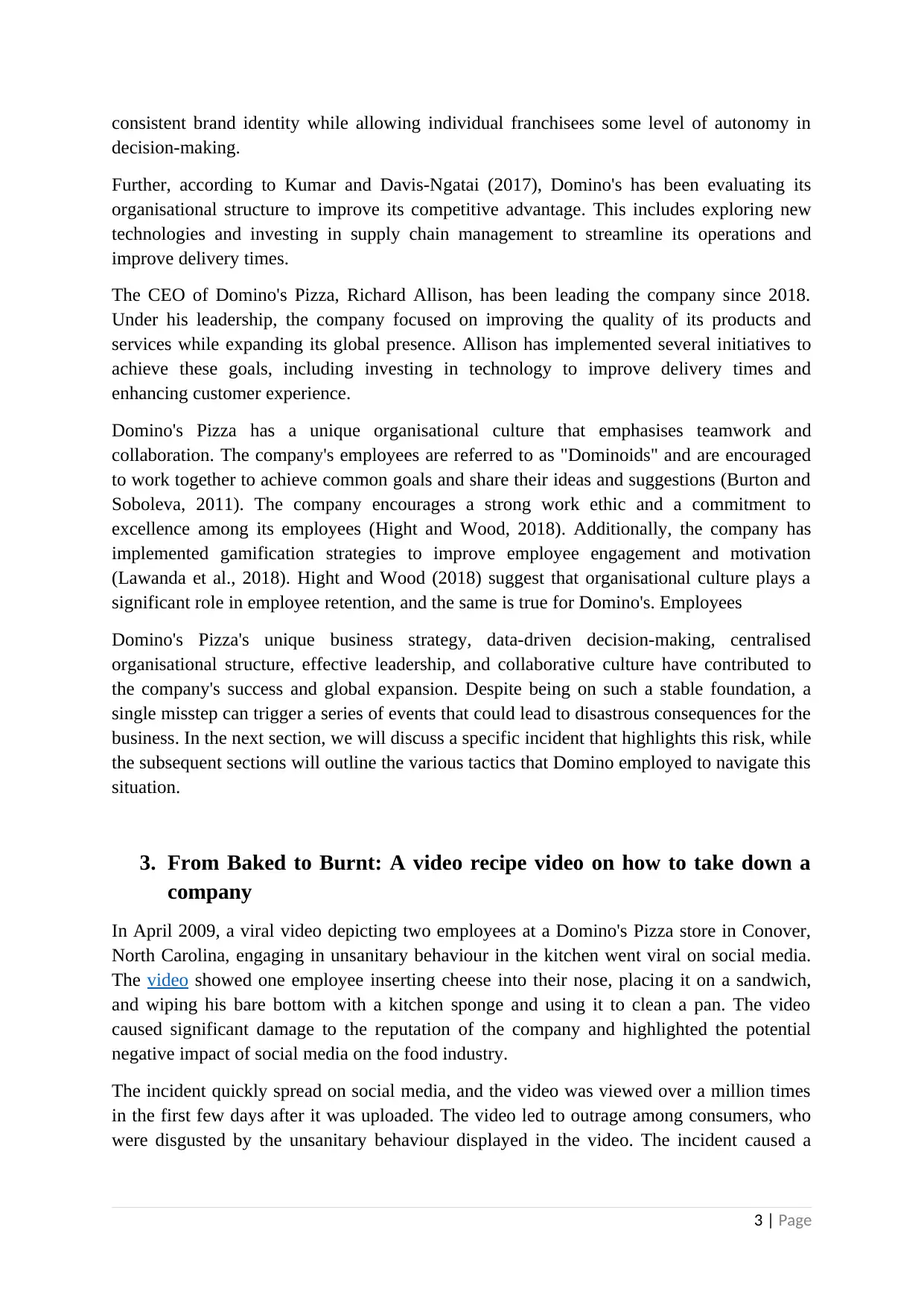
consistent brand identity while allowing individual franchisees some level of autonomy in
decision-making.
Further, according to Kumar and Davis-Ngatai (2017), Domino's has been evaluating its
organisational structure to improve its competitive advantage. This includes exploring new
technologies and investing in supply chain management to streamline its operations and
improve delivery times.
The CEO of Domino's Pizza, Richard Allison, has been leading the company since 2018.
Under his leadership, the company focused on improving the quality of its products and
services while expanding its global presence. Allison has implemented several initiatives to
achieve these goals, including investing in technology to improve delivery times and
enhancing customer experience.
Domino's Pizza has a unique organisational culture that emphasises teamwork and
collaboration. The company's employees are referred to as "Dominoids" and are encouraged
to work together to achieve common goals and share their ideas and suggestions (Burton and
Soboleva, 2011). The company encourages a strong work ethic and a commitment to
excellence among its employees (Hight and Wood, 2018). Additionally, the company has
implemented gamification strategies to improve employee engagement and motivation
(Lawanda et al., 2018). Hight and Wood (2018) suggest that organisational culture plays a
significant role in employee retention, and the same is true for Domino's. Employees
Domino's Pizza's unique business strategy, data-driven decision-making, centralised
organisational structure, effective leadership, and collaborative culture have contributed to
the company's success and global expansion. Despite being on such a stable foundation, a
single misstep can trigger a series of events that could lead to disastrous consequences for the
business. In the next section, we will discuss a specific incident that highlights this risk, while
the subsequent sections will outline the various tactics that Domino employed to navigate this
situation.
3. From Baked to Burnt: A video recipe video on how to take down a
company
In April 2009, a viral video depicting two employees at a Domino's Pizza store in Conover,
North Carolina, engaging in unsanitary behaviour in the kitchen went viral on social media.
The video showed one employee inserting cheese into their nose, placing it on a sandwich,
and wiping his bare bottom with a kitchen sponge and using it to clean a pan. The video
caused significant damage to the reputation of the company and highlighted the potential
negative impact of social media on the food industry.
The incident quickly spread on social media, and the video was viewed over a million times
in the first few days after it was uploaded. The video led to outrage among consumers, who
were disgusted by the unsanitary behaviour displayed in the video. The incident caused a
3 | Page
decision-making.
Further, according to Kumar and Davis-Ngatai (2017), Domino's has been evaluating its
organisational structure to improve its competitive advantage. This includes exploring new
technologies and investing in supply chain management to streamline its operations and
improve delivery times.
The CEO of Domino's Pizza, Richard Allison, has been leading the company since 2018.
Under his leadership, the company focused on improving the quality of its products and
services while expanding its global presence. Allison has implemented several initiatives to
achieve these goals, including investing in technology to improve delivery times and
enhancing customer experience.
Domino's Pizza has a unique organisational culture that emphasises teamwork and
collaboration. The company's employees are referred to as "Dominoids" and are encouraged
to work together to achieve common goals and share their ideas and suggestions (Burton and
Soboleva, 2011). The company encourages a strong work ethic and a commitment to
excellence among its employees (Hight and Wood, 2018). Additionally, the company has
implemented gamification strategies to improve employee engagement and motivation
(Lawanda et al., 2018). Hight and Wood (2018) suggest that organisational culture plays a
significant role in employee retention, and the same is true for Domino's. Employees
Domino's Pizza's unique business strategy, data-driven decision-making, centralised
organisational structure, effective leadership, and collaborative culture have contributed to
the company's success and global expansion. Despite being on such a stable foundation, a
single misstep can trigger a series of events that could lead to disastrous consequences for the
business. In the next section, we will discuss a specific incident that highlights this risk, while
the subsequent sections will outline the various tactics that Domino employed to navigate this
situation.
3. From Baked to Burnt: A video recipe video on how to take down a
company
In April 2009, a viral video depicting two employees at a Domino's Pizza store in Conover,
North Carolina, engaging in unsanitary behaviour in the kitchen went viral on social media.
The video showed one employee inserting cheese into their nose, placing it on a sandwich,
and wiping his bare bottom with a kitchen sponge and using it to clean a pan. The video
caused significant damage to the reputation of the company and highlighted the potential
negative impact of social media on the food industry.
The incident quickly spread on social media, and the video was viewed over a million times
in the first few days after it was uploaded. The video led to outrage among consumers, who
were disgusted by the unsanitary behaviour displayed in the video. The incident caused a
3 | Page
Secure Best Marks with AI Grader
Need help grading? Try our AI Grader for instant feedback on your assignments.
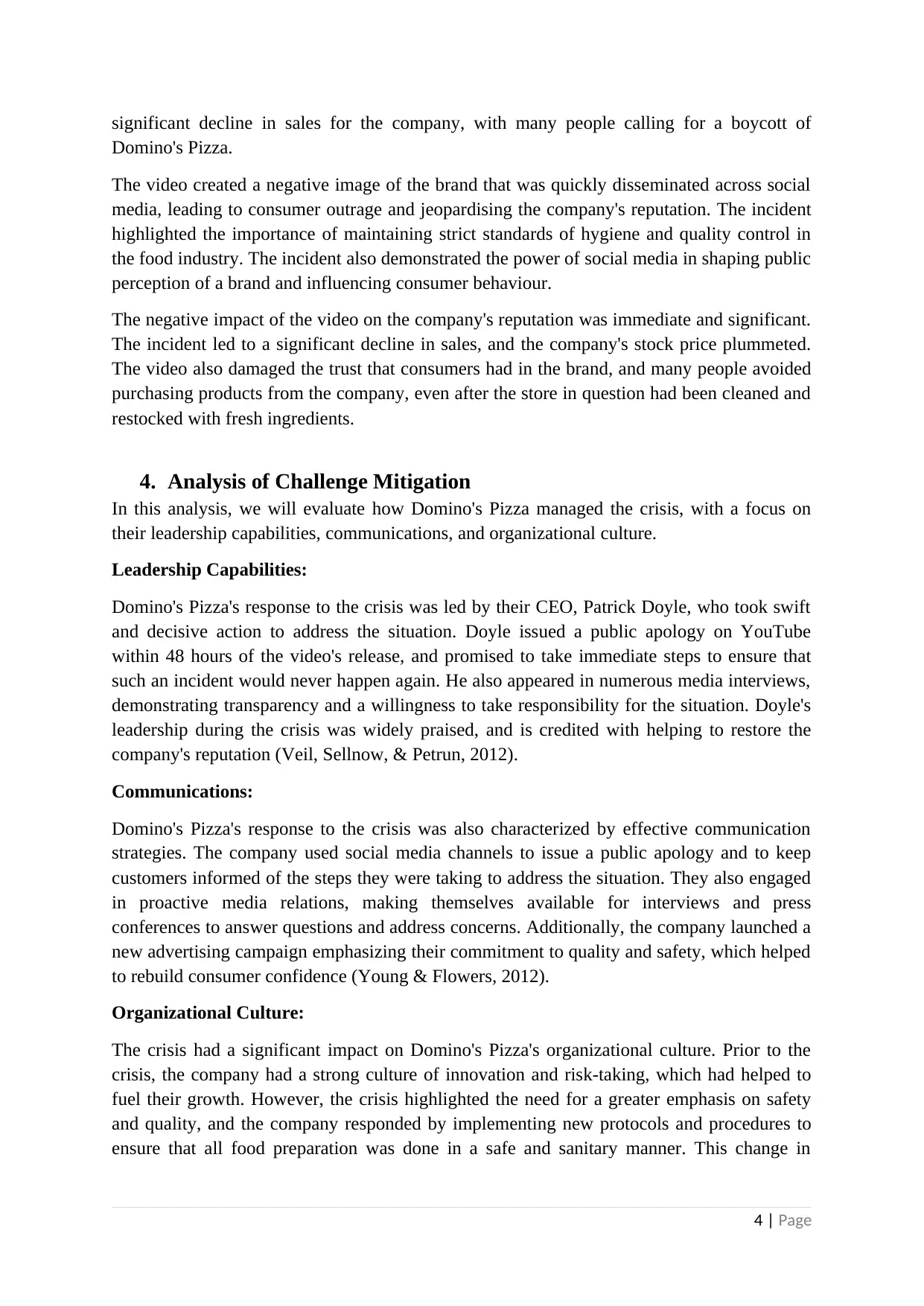
significant decline in sales for the company, with many people calling for a boycott of
Domino's Pizza.
The video created a negative image of the brand that was quickly disseminated across social
media, leading to consumer outrage and jeopardising the company's reputation. The incident
highlighted the importance of maintaining strict standards of hygiene and quality control in
the food industry. The incident also demonstrated the power of social media in shaping public
perception of a brand and influencing consumer behaviour.
The negative impact of the video on the company's reputation was immediate and significant.
The incident led to a significant decline in sales, and the company's stock price plummeted.
The video also damaged the trust that consumers had in the brand, and many people avoided
purchasing products from the company, even after the store in question had been cleaned and
restocked with fresh ingredients.
4. Analysis of Challenge Mitigation
In this analysis, we will evaluate how Domino's Pizza managed the crisis, with a focus on
their leadership capabilities, communications, and organizational culture.
Leadership Capabilities:
Domino's Pizza's response to the crisis was led by their CEO, Patrick Doyle, who took swift
and decisive action to address the situation. Doyle issued a public apology on YouTube
within 48 hours of the video's release, and promised to take immediate steps to ensure that
such an incident would never happen again. He also appeared in numerous media interviews,
demonstrating transparency and a willingness to take responsibility for the situation. Doyle's
leadership during the crisis was widely praised, and is credited with helping to restore the
company's reputation (Veil, Sellnow, & Petrun, 2012).
Communications:
Domino's Pizza's response to the crisis was also characterized by effective communication
strategies. The company used social media channels to issue a public apology and to keep
customers informed of the steps they were taking to address the situation. They also engaged
in proactive media relations, making themselves available for interviews and press
conferences to answer questions and address concerns. Additionally, the company launched a
new advertising campaign emphasizing their commitment to quality and safety, which helped
to rebuild consumer confidence (Young & Flowers, 2012).
Organizational Culture:
The crisis had a significant impact on Domino's Pizza's organizational culture. Prior to the
crisis, the company had a strong culture of innovation and risk-taking, which had helped to
fuel their growth. However, the crisis highlighted the need for a greater emphasis on safety
and quality, and the company responded by implementing new protocols and procedures to
ensure that all food preparation was done in a safe and sanitary manner. This change in
4 | Page
Domino's Pizza.
The video created a negative image of the brand that was quickly disseminated across social
media, leading to consumer outrage and jeopardising the company's reputation. The incident
highlighted the importance of maintaining strict standards of hygiene and quality control in
the food industry. The incident also demonstrated the power of social media in shaping public
perception of a brand and influencing consumer behaviour.
The negative impact of the video on the company's reputation was immediate and significant.
The incident led to a significant decline in sales, and the company's stock price plummeted.
The video also damaged the trust that consumers had in the brand, and many people avoided
purchasing products from the company, even after the store in question had been cleaned and
restocked with fresh ingredients.
4. Analysis of Challenge Mitigation
In this analysis, we will evaluate how Domino's Pizza managed the crisis, with a focus on
their leadership capabilities, communications, and organizational culture.
Leadership Capabilities:
Domino's Pizza's response to the crisis was led by their CEO, Patrick Doyle, who took swift
and decisive action to address the situation. Doyle issued a public apology on YouTube
within 48 hours of the video's release, and promised to take immediate steps to ensure that
such an incident would never happen again. He also appeared in numerous media interviews,
demonstrating transparency and a willingness to take responsibility for the situation. Doyle's
leadership during the crisis was widely praised, and is credited with helping to restore the
company's reputation (Veil, Sellnow, & Petrun, 2012).
Communications:
Domino's Pizza's response to the crisis was also characterized by effective communication
strategies. The company used social media channels to issue a public apology and to keep
customers informed of the steps they were taking to address the situation. They also engaged
in proactive media relations, making themselves available for interviews and press
conferences to answer questions and address concerns. Additionally, the company launched a
new advertising campaign emphasizing their commitment to quality and safety, which helped
to rebuild consumer confidence (Young & Flowers, 2012).
Organizational Culture:
The crisis had a significant impact on Domino's Pizza's organizational culture. Prior to the
crisis, the company had a strong culture of innovation and risk-taking, which had helped to
fuel their growth. However, the crisis highlighted the need for a greater emphasis on safety
and quality, and the company responded by implementing new protocols and procedures to
ensure that all food preparation was done in a safe and sanitary manner. This change in
4 | Page
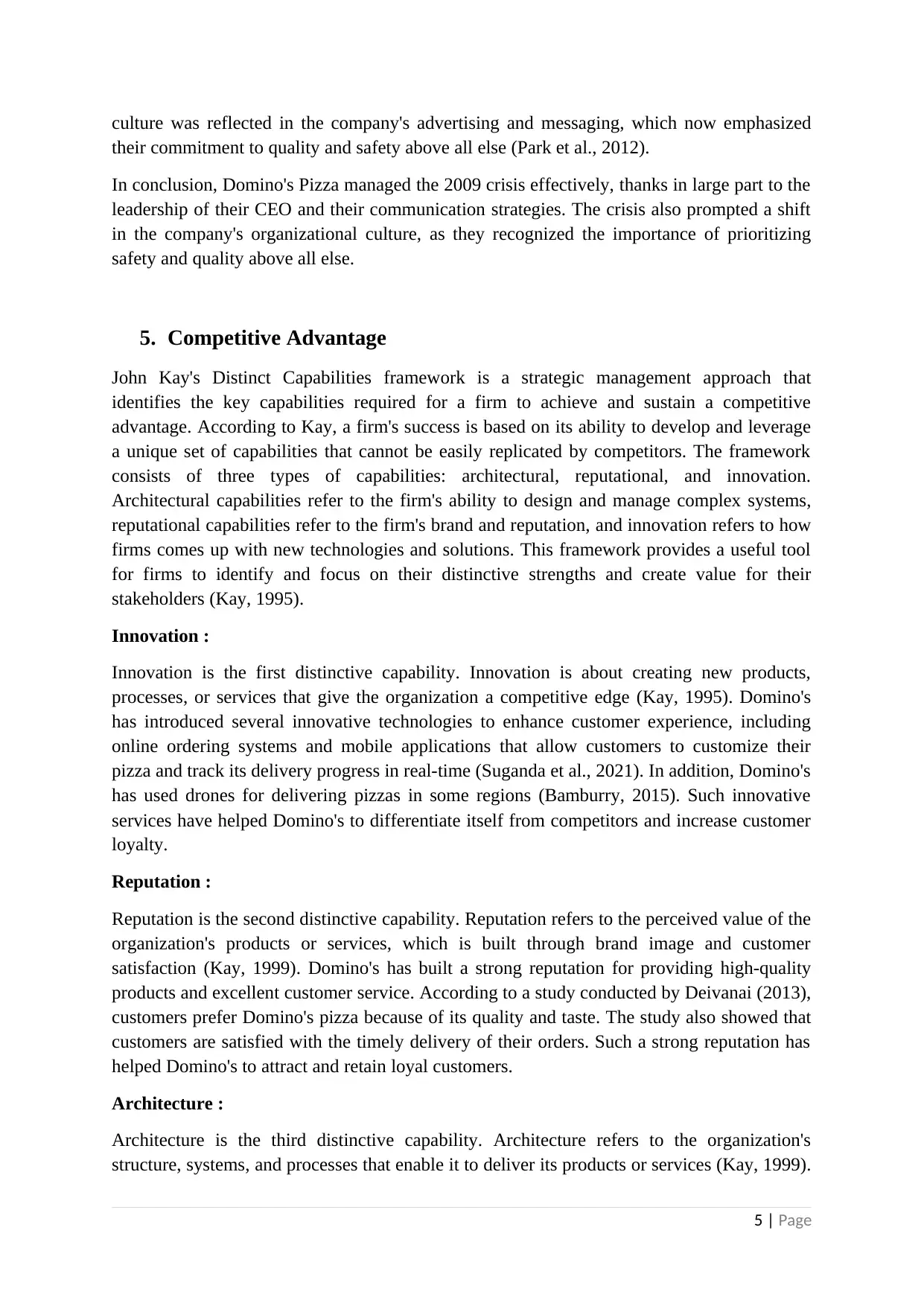
culture was reflected in the company's advertising and messaging, which now emphasized
their commitment to quality and safety above all else (Park et al., 2012).
In conclusion, Domino's Pizza managed the 2009 crisis effectively, thanks in large part to the
leadership of their CEO and their communication strategies. The crisis also prompted a shift
in the company's organizational culture, as they recognized the importance of prioritizing
safety and quality above all else.
5. Competitive Advantage
John Kay's Distinct Capabilities framework is a strategic management approach that
identifies the key capabilities required for a firm to achieve and sustain a competitive
advantage. According to Kay, a firm's success is based on its ability to develop and leverage
a unique set of capabilities that cannot be easily replicated by competitors. The framework
consists of three types of capabilities: architectural, reputational, and innovation.
Architectural capabilities refer to the firm's ability to design and manage complex systems,
reputational capabilities refer to the firm's brand and reputation, and innovation refers to how
firms comes up with new technologies and solutions. This framework provides a useful tool
for firms to identify and focus on their distinctive strengths and create value for their
stakeholders (Kay, 1995).
Innovation :
Innovation is the first distinctive capability. Innovation is about creating new products,
processes, or services that give the organization a competitive edge (Kay, 1995). Domino's
has introduced several innovative technologies to enhance customer experience, including
online ordering systems and mobile applications that allow customers to customize their
pizza and track its delivery progress in real-time (Suganda et al., 2021). In addition, Domino's
has used drones for delivering pizzas in some regions (Bamburry, 2015). Such innovative
services have helped Domino's to differentiate itself from competitors and increase customer
loyalty.
Reputation :
Reputation is the second distinctive capability. Reputation refers to the perceived value of the
organization's products or services, which is built through brand image and customer
satisfaction (Kay, 1999). Domino's has built a strong reputation for providing high-quality
products and excellent customer service. According to a study conducted by Deivanai (2013),
customers prefer Domino's pizza because of its quality and taste. The study also showed that
customers are satisfied with the timely delivery of their orders. Such a strong reputation has
helped Domino's to attract and retain loyal customers.
Architecture :
Architecture is the third distinctive capability. Architecture refers to the organization's
structure, systems, and processes that enable it to deliver its products or services (Kay, 1999).
5 | Page
their commitment to quality and safety above all else (Park et al., 2012).
In conclusion, Domino's Pizza managed the 2009 crisis effectively, thanks in large part to the
leadership of their CEO and their communication strategies. The crisis also prompted a shift
in the company's organizational culture, as they recognized the importance of prioritizing
safety and quality above all else.
5. Competitive Advantage
John Kay's Distinct Capabilities framework is a strategic management approach that
identifies the key capabilities required for a firm to achieve and sustain a competitive
advantage. According to Kay, a firm's success is based on its ability to develop and leverage
a unique set of capabilities that cannot be easily replicated by competitors. The framework
consists of three types of capabilities: architectural, reputational, and innovation.
Architectural capabilities refer to the firm's ability to design and manage complex systems,
reputational capabilities refer to the firm's brand and reputation, and innovation refers to how
firms comes up with new technologies and solutions. This framework provides a useful tool
for firms to identify and focus on their distinctive strengths and create value for their
stakeholders (Kay, 1995).
Innovation :
Innovation is the first distinctive capability. Innovation is about creating new products,
processes, or services that give the organization a competitive edge (Kay, 1995). Domino's
has introduced several innovative technologies to enhance customer experience, including
online ordering systems and mobile applications that allow customers to customize their
pizza and track its delivery progress in real-time (Suganda et al., 2021). In addition, Domino's
has used drones for delivering pizzas in some regions (Bamburry, 2015). Such innovative
services have helped Domino's to differentiate itself from competitors and increase customer
loyalty.
Reputation :
Reputation is the second distinctive capability. Reputation refers to the perceived value of the
organization's products or services, which is built through brand image and customer
satisfaction (Kay, 1999). Domino's has built a strong reputation for providing high-quality
products and excellent customer service. According to a study conducted by Deivanai (2013),
customers prefer Domino's pizza because of its quality and taste. The study also showed that
customers are satisfied with the timely delivery of their orders. Such a strong reputation has
helped Domino's to attract and retain loyal customers.
Architecture :
Architecture is the third distinctive capability. Architecture refers to the organization's
structure, systems, and processes that enable it to deliver its products or services (Kay, 1999).
5 | Page
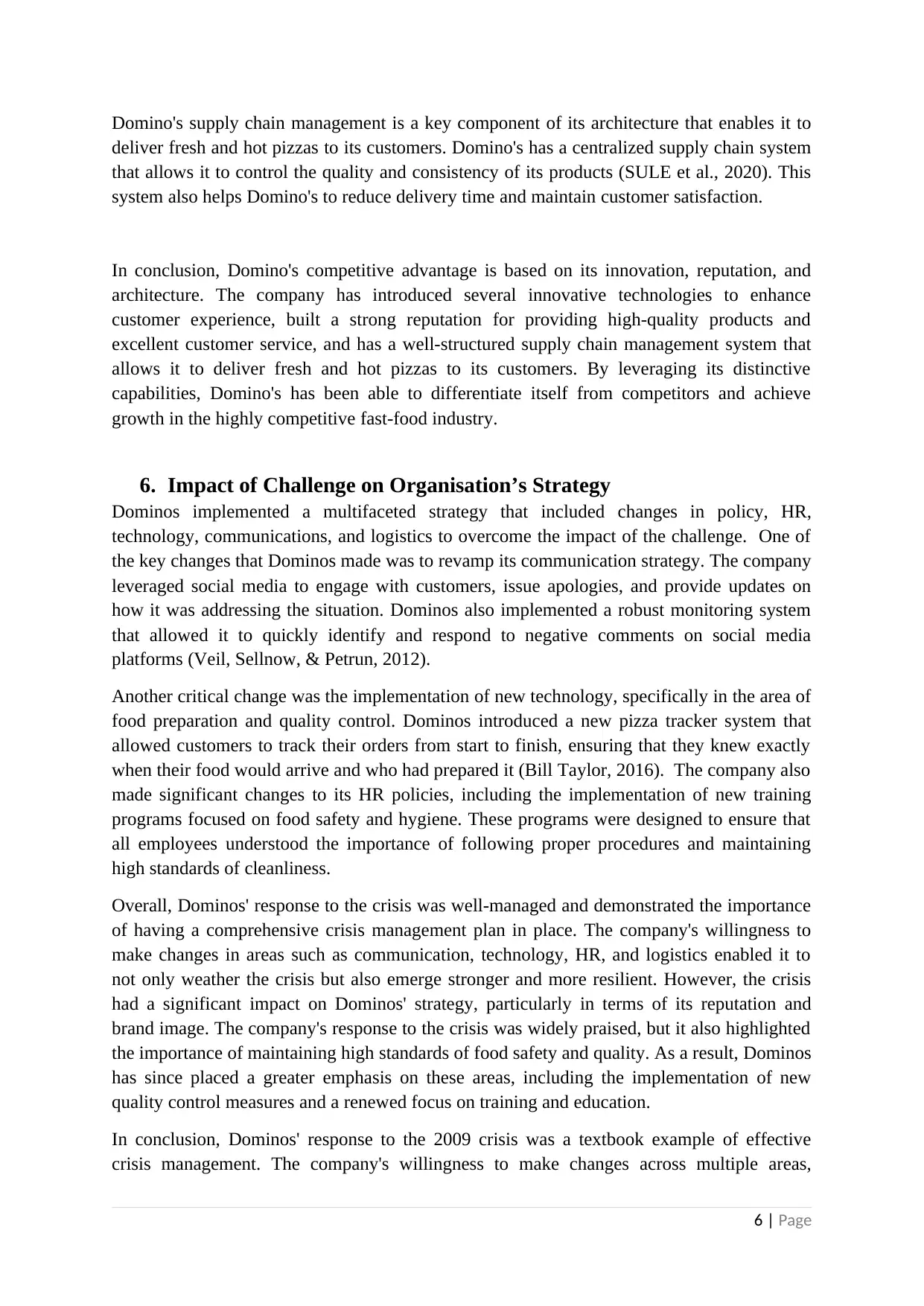
Domino's supply chain management is a key component of its architecture that enables it to
deliver fresh and hot pizzas to its customers. Domino's has a centralized supply chain system
that allows it to control the quality and consistency of its products (SULE et al., 2020). This
system also helps Domino's to reduce delivery time and maintain customer satisfaction.
In conclusion, Domino's competitive advantage is based on its innovation, reputation, and
architecture. The company has introduced several innovative technologies to enhance
customer experience, built a strong reputation for providing high-quality products and
excellent customer service, and has a well-structured supply chain management system that
allows it to deliver fresh and hot pizzas to its customers. By leveraging its distinctive
capabilities, Domino's has been able to differentiate itself from competitors and achieve
growth in the highly competitive fast-food industry.
6. Impact of Challenge on Organisation’s Strategy
Dominos implemented a multifaceted strategy that included changes in policy, HR,
technology, communications, and logistics to overcome the impact of the challenge. One of
the key changes that Dominos made was to revamp its communication strategy. The company
leveraged social media to engage with customers, issue apologies, and provide updates on
how it was addressing the situation. Dominos also implemented a robust monitoring system
that allowed it to quickly identify and respond to negative comments on social media
platforms (Veil, Sellnow, & Petrun, 2012).
Another critical change was the implementation of new technology, specifically in the area of
food preparation and quality control. Dominos introduced a new pizza tracker system that
allowed customers to track their orders from start to finish, ensuring that they knew exactly
when their food would arrive and who had prepared it (Bill Taylor, 2016). The company also
made significant changes to its HR policies, including the implementation of new training
programs focused on food safety and hygiene. These programs were designed to ensure that
all employees understood the importance of following proper procedures and maintaining
high standards of cleanliness.
Overall, Dominos' response to the crisis was well-managed and demonstrated the importance
of having a comprehensive crisis management plan in place. The company's willingness to
make changes in areas such as communication, technology, HR, and logistics enabled it to
not only weather the crisis but also emerge stronger and more resilient. However, the crisis
had a significant impact on Dominos' strategy, particularly in terms of its reputation and
brand image. The company's response to the crisis was widely praised, but it also highlighted
the importance of maintaining high standards of food safety and quality. As a result, Dominos
has since placed a greater emphasis on these areas, including the implementation of new
quality control measures and a renewed focus on training and education.
In conclusion, Dominos' response to the 2009 crisis was a textbook example of effective
crisis management. The company's willingness to make changes across multiple areas,
6 | Page
deliver fresh and hot pizzas to its customers. Domino's has a centralized supply chain system
that allows it to control the quality and consistency of its products (SULE et al., 2020). This
system also helps Domino's to reduce delivery time and maintain customer satisfaction.
In conclusion, Domino's competitive advantage is based on its innovation, reputation, and
architecture. The company has introduced several innovative technologies to enhance
customer experience, built a strong reputation for providing high-quality products and
excellent customer service, and has a well-structured supply chain management system that
allows it to deliver fresh and hot pizzas to its customers. By leveraging its distinctive
capabilities, Domino's has been able to differentiate itself from competitors and achieve
growth in the highly competitive fast-food industry.
6. Impact of Challenge on Organisation’s Strategy
Dominos implemented a multifaceted strategy that included changes in policy, HR,
technology, communications, and logistics to overcome the impact of the challenge. One of
the key changes that Dominos made was to revamp its communication strategy. The company
leveraged social media to engage with customers, issue apologies, and provide updates on
how it was addressing the situation. Dominos also implemented a robust monitoring system
that allowed it to quickly identify and respond to negative comments on social media
platforms (Veil, Sellnow, & Petrun, 2012).
Another critical change was the implementation of new technology, specifically in the area of
food preparation and quality control. Dominos introduced a new pizza tracker system that
allowed customers to track their orders from start to finish, ensuring that they knew exactly
when their food would arrive and who had prepared it (Bill Taylor, 2016). The company also
made significant changes to its HR policies, including the implementation of new training
programs focused on food safety and hygiene. These programs were designed to ensure that
all employees understood the importance of following proper procedures and maintaining
high standards of cleanliness.
Overall, Dominos' response to the crisis was well-managed and demonstrated the importance
of having a comprehensive crisis management plan in place. The company's willingness to
make changes in areas such as communication, technology, HR, and logistics enabled it to
not only weather the crisis but also emerge stronger and more resilient. However, the crisis
had a significant impact on Dominos' strategy, particularly in terms of its reputation and
brand image. The company's response to the crisis was widely praised, but it also highlighted
the importance of maintaining high standards of food safety and quality. As a result, Dominos
has since placed a greater emphasis on these areas, including the implementation of new
quality control measures and a renewed focus on training and education.
In conclusion, Dominos' response to the 2009 crisis was a textbook example of effective
crisis management. The company's willingness to make changes across multiple areas,
6 | Page
Paraphrase This Document
Need a fresh take? Get an instant paraphrase of this document with our AI Paraphraser
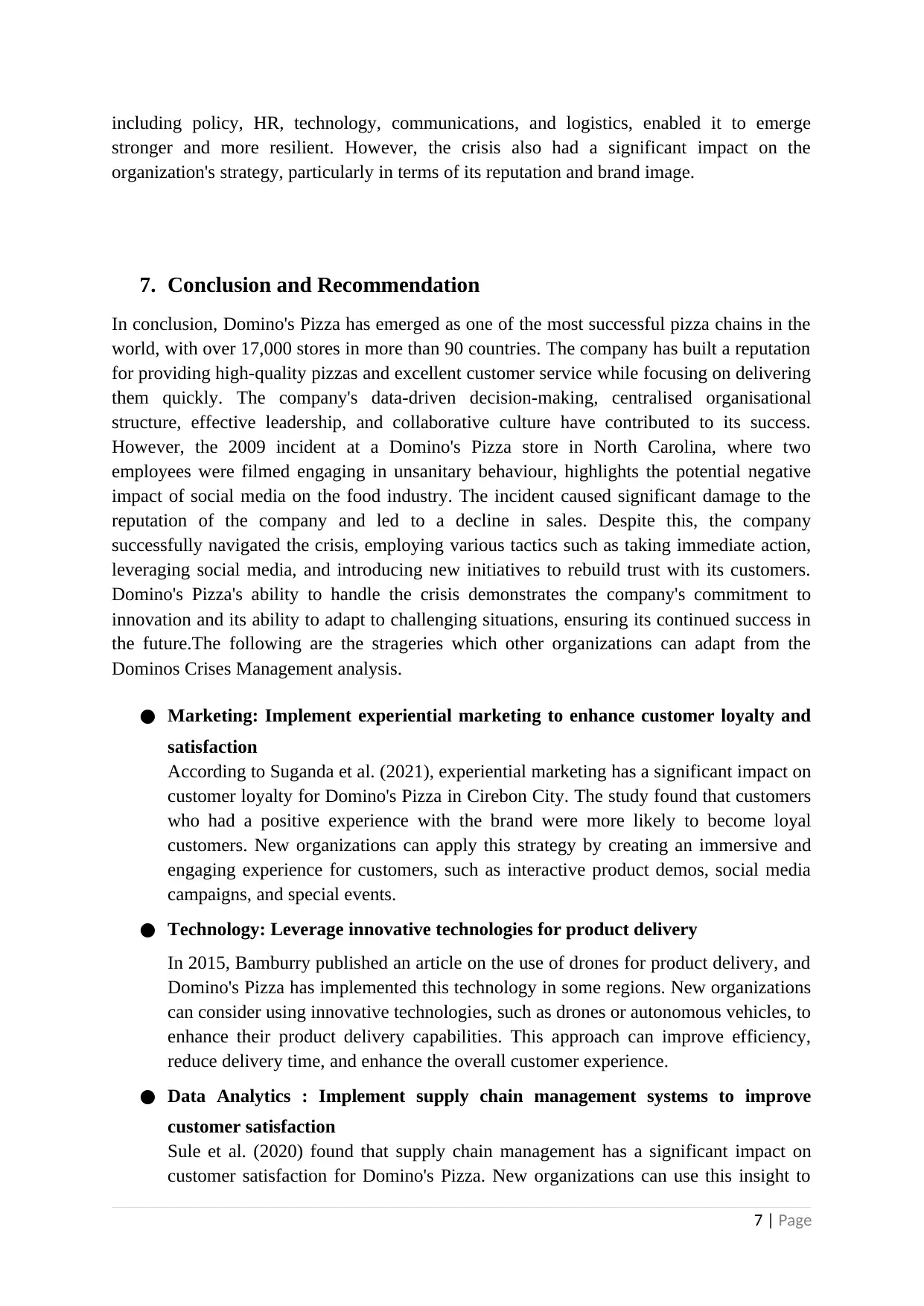
including policy, HR, technology, communications, and logistics, enabled it to emerge
stronger and more resilient. However, the crisis also had a significant impact on the
organization's strategy, particularly in terms of its reputation and brand image.
7. Conclusion and Recommendation
In conclusion, Domino's Pizza has emerged as one of the most successful pizza chains in the
world, with over 17,000 stores in more than 90 countries. The company has built a reputation
for providing high-quality pizzas and excellent customer service while focusing on delivering
them quickly. The company's data-driven decision-making, centralised organisational
structure, effective leadership, and collaborative culture have contributed to its success.
However, the 2009 incident at a Domino's Pizza store in North Carolina, where two
employees were filmed engaging in unsanitary behaviour, highlights the potential negative
impact of social media on the food industry. The incident caused significant damage to the
reputation of the company and led to a decline in sales. Despite this, the company
successfully navigated the crisis, employing various tactics such as taking immediate action,
leveraging social media, and introducing new initiatives to rebuild trust with its customers.
Domino's Pizza's ability to handle the crisis demonstrates the company's commitment to
innovation and its ability to adapt to challenging situations, ensuring its continued success in
the future.The following are the strageries which other organizations can adapt from the
Dominos Crises Management analysis.
● Marketing: Implement experiential marketing to enhance customer loyalty and
satisfaction
According to Suganda et al. (2021), experiential marketing has a significant impact on
customer loyalty for Domino's Pizza in Cirebon City. The study found that customers
who had a positive experience with the brand were more likely to become loyal
customers. New organizations can apply this strategy by creating an immersive and
engaging experience for customers, such as interactive product demos, social media
campaigns, and special events.
● Technology: Leverage innovative technologies for product delivery
In 2015, Bamburry published an article on the use of drones for product delivery, and
Domino's Pizza has implemented this technology in some regions. New organizations
can consider using innovative technologies, such as drones or autonomous vehicles, to
enhance their product delivery capabilities. This approach can improve efficiency,
reduce delivery time, and enhance the overall customer experience.
● Data Analytics : Implement supply chain management systems to improve
customer satisfaction
Sule et al. (2020) found that supply chain management has a significant impact on
customer satisfaction for Domino's Pizza. New organizations can use this insight to
7 | Page
stronger and more resilient. However, the crisis also had a significant impact on the
organization's strategy, particularly in terms of its reputation and brand image.
7. Conclusion and Recommendation
In conclusion, Domino's Pizza has emerged as one of the most successful pizza chains in the
world, with over 17,000 stores in more than 90 countries. The company has built a reputation
for providing high-quality pizzas and excellent customer service while focusing on delivering
them quickly. The company's data-driven decision-making, centralised organisational
structure, effective leadership, and collaborative culture have contributed to its success.
However, the 2009 incident at a Domino's Pizza store in North Carolina, where two
employees were filmed engaging in unsanitary behaviour, highlights the potential negative
impact of social media on the food industry. The incident caused significant damage to the
reputation of the company and led to a decline in sales. Despite this, the company
successfully navigated the crisis, employing various tactics such as taking immediate action,
leveraging social media, and introducing new initiatives to rebuild trust with its customers.
Domino's Pizza's ability to handle the crisis demonstrates the company's commitment to
innovation and its ability to adapt to challenging situations, ensuring its continued success in
the future.The following are the strageries which other organizations can adapt from the
Dominos Crises Management analysis.
● Marketing: Implement experiential marketing to enhance customer loyalty and
satisfaction
According to Suganda et al. (2021), experiential marketing has a significant impact on
customer loyalty for Domino's Pizza in Cirebon City. The study found that customers
who had a positive experience with the brand were more likely to become loyal
customers. New organizations can apply this strategy by creating an immersive and
engaging experience for customers, such as interactive product demos, social media
campaigns, and special events.
● Technology: Leverage innovative technologies for product delivery
In 2015, Bamburry published an article on the use of drones for product delivery, and
Domino's Pizza has implemented this technology in some regions. New organizations
can consider using innovative technologies, such as drones or autonomous vehicles, to
enhance their product delivery capabilities. This approach can improve efficiency,
reduce delivery time, and enhance the overall customer experience.
● Data Analytics : Implement supply chain management systems to improve
customer satisfaction
Sule et al. (2020) found that supply chain management has a significant impact on
customer satisfaction for Domino's Pizza. New organizations can use this insight to
7 | Page
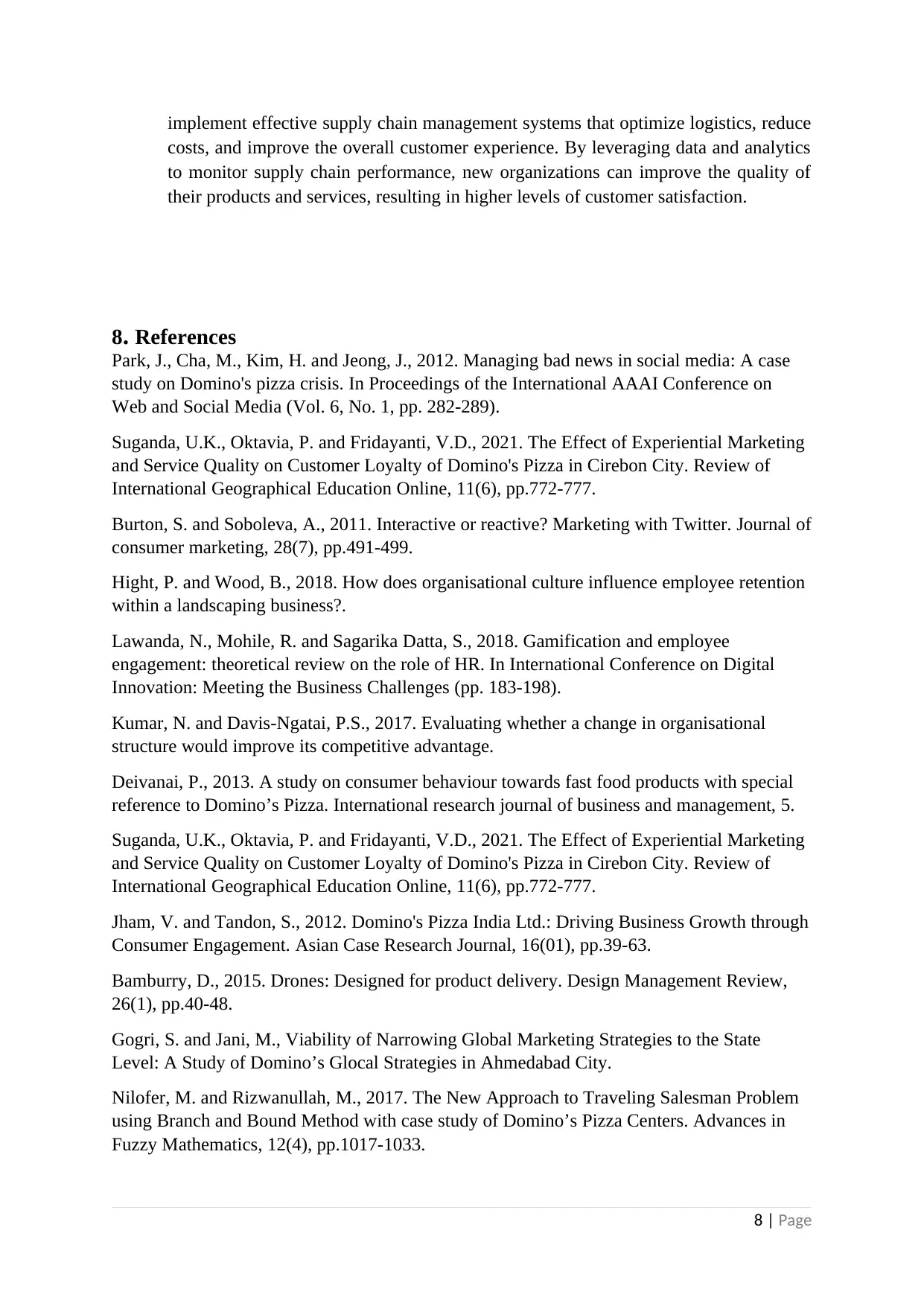
implement effective supply chain management systems that optimize logistics, reduce
costs, and improve the overall customer experience. By leveraging data and analytics
to monitor supply chain performance, new organizations can improve the quality of
their products and services, resulting in higher levels of customer satisfaction.
8. References
Park, J., Cha, M., Kim, H. and Jeong, J., 2012. Managing bad news in social media: A case
study on Domino's pizza crisis. In Proceedings of the International AAAI Conference on
Web and Social Media (Vol. 6, No. 1, pp. 282-289).
Suganda, U.K., Oktavia, P. and Fridayanti, V.D., 2021. The Effect of Experiential Marketing
and Service Quality on Customer Loyalty of Domino's Pizza in Cirebon City. Review of
International Geographical Education Online, 11(6), pp.772-777.
Burton, S. and Soboleva, A., 2011. Interactive or reactive? Marketing with Twitter. Journal of
consumer marketing, 28(7), pp.491-499.
Hight, P. and Wood, B., 2018. How does organisational culture influence employee retention
within a landscaping business?.
Lawanda, N., Mohile, R. and Sagarika Datta, S., 2018. Gamification and employee
engagement: theoretical review on the role of HR. In International Conference on Digital
Innovation: Meeting the Business Challenges (pp. 183-198).
Kumar, N. and Davis-Ngatai, P.S., 2017. Evaluating whether a change in organisational
structure would improve its competitive advantage.
Deivanai, P., 2013. A study on consumer behaviour towards fast food products with special
reference to Domino’s Pizza. International research journal of business and management, 5.
Suganda, U.K., Oktavia, P. and Fridayanti, V.D., 2021. The Effect of Experiential Marketing
and Service Quality on Customer Loyalty of Domino's Pizza in Cirebon City. Review of
International Geographical Education Online, 11(6), pp.772-777.
Jham, V. and Tandon, S., 2012. Domino's Pizza India Ltd.: Driving Business Growth through
Consumer Engagement. Asian Case Research Journal, 16(01), pp.39-63.
Bamburry, D., 2015. Drones: Designed for product delivery. Design Management Review,
26(1), pp.40-48.
Gogri, S. and Jani, M., Viability of Narrowing Global Marketing Strategies to the State
Level: A Study of Domino’s Glocal Strategies in Ahmedabad City.
Nilofer, M. and Rizwanullah, M., 2017. The New Approach to Traveling Salesman Problem
using Branch and Bound Method with case study of Domino’s Pizza Centers. Advances in
Fuzzy Mathematics, 12(4), pp.1017-1033.
8 | Page
costs, and improve the overall customer experience. By leveraging data and analytics
to monitor supply chain performance, new organizations can improve the quality of
their products and services, resulting in higher levels of customer satisfaction.
8. References
Park, J., Cha, M., Kim, H. and Jeong, J., 2012. Managing bad news in social media: A case
study on Domino's pizza crisis. In Proceedings of the International AAAI Conference on
Web and Social Media (Vol. 6, No. 1, pp. 282-289).
Suganda, U.K., Oktavia, P. and Fridayanti, V.D., 2021. The Effect of Experiential Marketing
and Service Quality on Customer Loyalty of Domino's Pizza in Cirebon City. Review of
International Geographical Education Online, 11(6), pp.772-777.
Burton, S. and Soboleva, A., 2011. Interactive or reactive? Marketing with Twitter. Journal of
consumer marketing, 28(7), pp.491-499.
Hight, P. and Wood, B., 2018. How does organisational culture influence employee retention
within a landscaping business?.
Lawanda, N., Mohile, R. and Sagarika Datta, S., 2018. Gamification and employee
engagement: theoretical review on the role of HR. In International Conference on Digital
Innovation: Meeting the Business Challenges (pp. 183-198).
Kumar, N. and Davis-Ngatai, P.S., 2017. Evaluating whether a change in organisational
structure would improve its competitive advantage.
Deivanai, P., 2013. A study on consumer behaviour towards fast food products with special
reference to Domino’s Pizza. International research journal of business and management, 5.
Suganda, U.K., Oktavia, P. and Fridayanti, V.D., 2021. The Effect of Experiential Marketing
and Service Quality on Customer Loyalty of Domino's Pizza in Cirebon City. Review of
International Geographical Education Online, 11(6), pp.772-777.
Jham, V. and Tandon, S., 2012. Domino's Pizza India Ltd.: Driving Business Growth through
Consumer Engagement. Asian Case Research Journal, 16(01), pp.39-63.
Bamburry, D., 2015. Drones: Designed for product delivery. Design Management Review,
26(1), pp.40-48.
Gogri, S. and Jani, M., Viability of Narrowing Global Marketing Strategies to the State
Level: A Study of Domino’s Glocal Strategies in Ahmedabad City.
Nilofer, M. and Rizwanullah, M., 2017. The New Approach to Traveling Salesman Problem
using Branch and Bound Method with case study of Domino’s Pizza Centers. Advances in
Fuzzy Mathematics, 12(4), pp.1017-1033.
8 | Page
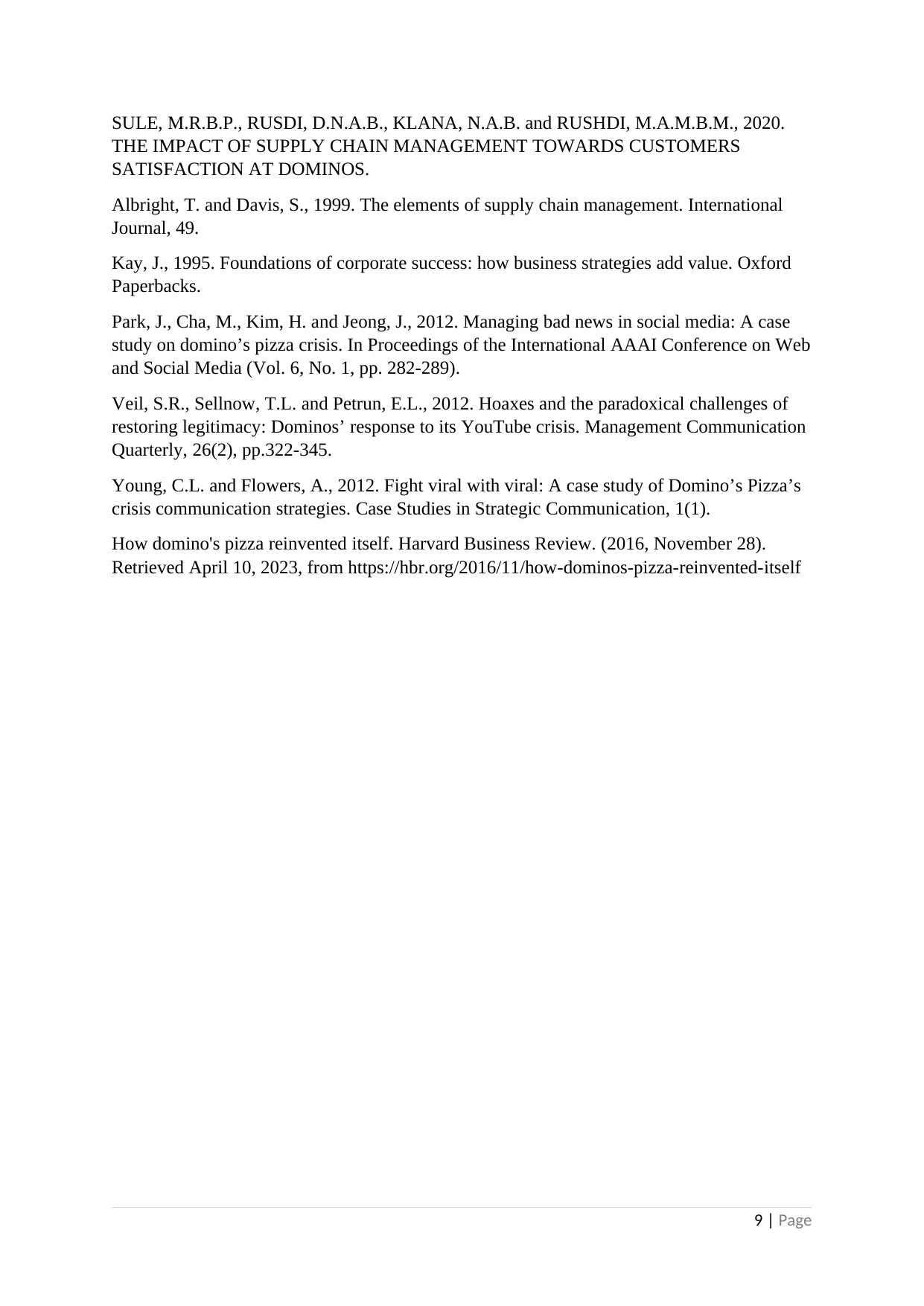
SULE, M.R.B.P., RUSDI, D.N.A.B., KLANA, N.A.B. and RUSHDI, M.A.M.B.M., 2020.
THE IMPACT OF SUPPLY CHAIN MANAGEMENT TOWARDS CUSTOMERS
SATISFACTION AT DOMINOS.
Albright, T. and Davis, S., 1999. The elements of supply chain management. International
Journal, 49.
Kay, J., 1995. Foundations of corporate success: how business strategies add value. Oxford
Paperbacks.
Park, J., Cha, M., Kim, H. and Jeong, J., 2012. Managing bad news in social media: A case
study on domino’s pizza crisis. In Proceedings of the International AAAI Conference on Web
and Social Media (Vol. 6, No. 1, pp. 282-289).
Veil, S.R., Sellnow, T.L. and Petrun, E.L., 2012. Hoaxes and the paradoxical challenges of
restoring legitimacy: Dominos’ response to its YouTube crisis. Management Communication
Quarterly, 26(2), pp.322-345.
Young, C.L. and Flowers, A., 2012. Fight viral with viral: A case study of Domino’s Pizza’s
crisis communication strategies. Case Studies in Strategic Communication, 1(1).
How domino's pizza reinvented itself. Harvard Business Review. (2016, November 28).
Retrieved April 10, 2023, from https://hbr.org/2016/11/how-dominos-pizza-reinvented-itself
9 | Page
THE IMPACT OF SUPPLY CHAIN MANAGEMENT TOWARDS CUSTOMERS
SATISFACTION AT DOMINOS.
Albright, T. and Davis, S., 1999. The elements of supply chain management. International
Journal, 49.
Kay, J., 1995. Foundations of corporate success: how business strategies add value. Oxford
Paperbacks.
Park, J., Cha, M., Kim, H. and Jeong, J., 2012. Managing bad news in social media: A case
study on domino’s pizza crisis. In Proceedings of the International AAAI Conference on Web
and Social Media (Vol. 6, No. 1, pp. 282-289).
Veil, S.R., Sellnow, T.L. and Petrun, E.L., 2012. Hoaxes and the paradoxical challenges of
restoring legitimacy: Dominos’ response to its YouTube crisis. Management Communication
Quarterly, 26(2), pp.322-345.
Young, C.L. and Flowers, A., 2012. Fight viral with viral: A case study of Domino’s Pizza’s
crisis communication strategies. Case Studies in Strategic Communication, 1(1).
How domino's pizza reinvented itself. Harvard Business Review. (2016, November 28).
Retrieved April 10, 2023, from https://hbr.org/2016/11/how-dominos-pizza-reinvented-itself
9 | Page
1 out of 10
Related Documents
Your All-in-One AI-Powered Toolkit for Academic Success.
+13062052269
info@desklib.com
Available 24*7 on WhatsApp / Email
![[object Object]](/_next/static/media/star-bottom.7253800d.svg)
Unlock your academic potential
© 2024 | Zucol Services PVT LTD | All rights reserved.




